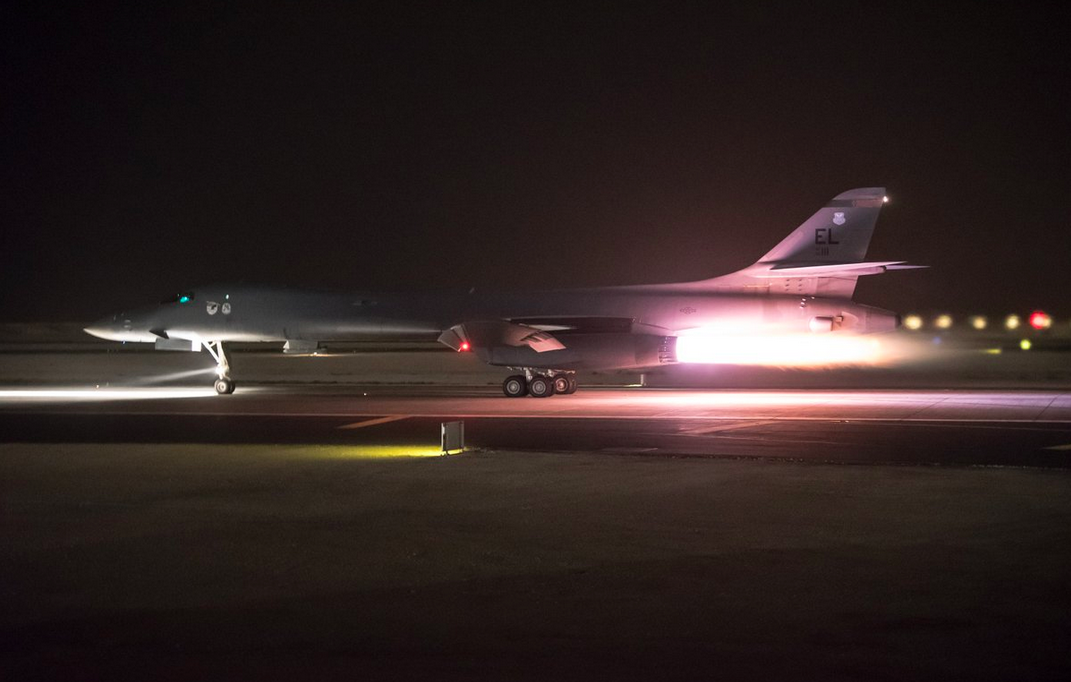
A B-1B deployed to Al Udeid AB, Qatar, takes off in support of a Friday night strike against Syrian chemical weapons facilities. AFCENT Twitter photo.
A large combination of US, United Kingdom, and French aircraft and ships on April 13 fired 105 total weapons aimed at crippling the chemical weapons infrastructure of Syrian President Bashar al-Assad, almost a week after the regime allegedly used chemical weapons on a suburb of the country’s capital.
The strike marked the first use of the AGM-158B Joint Air-to-Surface Standoff Missile-Extended Range weapon in combat. Two USAF B-1B Lancers from the 34th Expeditionary Bomb Squadron launched a total of 19 JASSM-ERs. The two bombers, deployed from Al Udeid AB, Qatar, entered Syrian airspace from the south and were escorted by a USMC E/A-6B Prowler.
President Trump ordered the strike at approximately 9 p.m. Eastern—4 a.m. in Syria—to demonstrate “international resolve to prevent chemical weapons from being used on anyone, under any circumstances, in contravention of international law,” Defense Secretary Jim Mattis said during a Friday briefing.
Mattis was flanked by Chairman of the Joint Chiefs of Staff USMC Gen. Joseph Dunford, French attache Brig. Gen. Jean-Pierre Montegu, and UK attache Air Vice Marshal Gavin Parker. The strike was organized alongside the allies to show the international commitment to the “long-term degradation of Syria’s capability to research, develop, and employ chemical and biological weapons,” Mattis said.
The French launched SCALP missiles from both the air and sea, while UK Tornados and Eurofighter Typhoons launched Storm Shadow missiles.
None of the air-launched nor sea-launched missiles were shot down by Syrian air defenses, Joint Staff Director USMC Lt. Gen. Kenneth McKenzie said at a Pentagon briefing Saturday morning.
Forty Syrian surface-to-air missiles were launched blindly in defense, and only “after the last impact” of weapons launched by the US-led force, he said. US officials warned that Syrian and Russian propaganda channels would try to point to damage from the surface-to-air missiles as evidence of an imprecise coalition attack, saying “if you shoot it into the air, it’s got to come down somewhere.”

The first target hit was the Barzeh Research and Development Center near Damascus, which was struck by 57 Tomahawks and all 19 JASSM-ERs. This building, located in “one of the most heavily defended airspace areas in the world,” was a major site of chemical weapons production, McKenzie said.
The second target was the Him Shinshar chemical weapons storage facility, which was hit by both UK and French missiles. Lastly, a chemical weapons bunker facility nearby was hit by French missiles, McKenzie said.
The “weaponeering and modeling” done for the strike aimed to limit civilian casualties, Dunford said.
A series of slides presented during the briefing showed relatively small and desolate structures destroyed by the strikes.
Pentagon spokeswoman Dana White, said that “Russian trolls”—internet propagandists—had stepped up activity by “2,000 percent” in the hours following the strikes.
McKenzie said there was no collateral damage observed from the strike, and suggested the timing of the attack was chosen to minimize casualties. He also said, without elaboration, that the strike was designed to “mitigate” the potential release of any stored chemical weapons.
Russian air defense systems in Syria did not fire at the striking aircraft or missiles, but McKenzie said they were active at the time of the raid. The usual deconfliction channels between US and Russian forces in the area were also active before the operation, but McKenzie said Russian forces were not tipped off or told that the strike was imminent. Russia gets “no veto” over US action in Syria, he asserted. There was no apparent immediate retaliation, but if it comes, “we’re ready for it,” McKenzie said.
The stealthy JASSM-ER missiles were likely launched outside the range of Syrian and Russian air defense systems. JASSM-ER, made by Lockheed Martin’s Missiles and Fire Control division, is an improved version of the JASSM missile, which started development in the late 1990s and, after a troubled development program marred more by testing snafus than design issues, became operational in the late 2000s.
The JASSM-ER version, which more than doubled the original JASSM’s range to 575 miles, became operational in 2014. It is loaded with target coordinates before launch and is not guided by the carrier aircraft. It uses a combination of GPS and precise Inertial Navigation System to find its way to the target, and uses a terminal guidance system employing a pattern-matching imaging infrared system. The B-1 can carry up to 24 JASSMs on rotary launchers in its two bomb bays.
The B-1Bs deployed from the 28th Bomb Wing at Ellsworth AFB, S.D., were accompanied by tankers, electronic warfare escort, and fighters for suppression of enemy air defenses.
The Navy launched 76 T-LAMs in the raid, from vessels in the Red Sea and Mediterranean Sea. Unlike the US strike launched just one year ago against a Syrian airfield—meant to punish Syria for chemical attacks at that time by targeting the delivery systems rather than the chemical weapons themselves—“none of the Tomahawks failed” in Saturday’s raid, McKenzie said.
Not all of Syria’s chemical weapons infrastructure was destroyed or even targeted by the raid, but McKenzie said, “I think we’ve dealt them a severe blow.”
Though President Trump suggested the raid was merely the first in potentially a series of attacks, McKenzie said no further strikes are planned. White asserted the next step is “up to” Syrian president Bashar Assad, and whether he “gets the message” that he may no longer employ chemical weapons. The force involved in the raid will remain in the region while the US observes the reaction from Syria and Russia, McKenzie noted.
See also Air Force Magazine’s infographic for more information on the various factions fighting in Syria’s seven-year civil war.